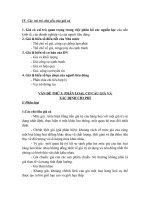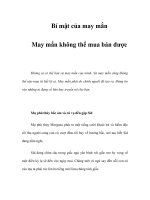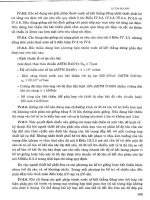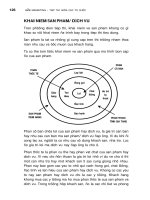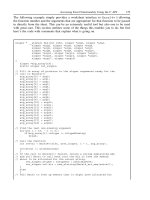Documentsbeyond transparency collective engagement in sustainable phần 6 docx
Bạn đang xem bản rút gọn của tài liệu. Xem và tải ngay bản đầy đủ của tài liệu tại đây (1.21 MB, 10 trang )
time,
these
locations
could
be
revealed
in
detail.
This
brings
up
a
nearly
universal
need
to
phase-in
supply
chain
transparency
by
temporarily
firewalling
sensitive
information
while
ensuring
that
the
impact
esti-
mates
remain
accurate.
Case
Study
I
The
Butcher
The
Butcher
grows
native
breeds
of
cattle
on
his
family
farm,
selling
the
beef
along
with
pork,
lamb
and
game
at
his
small-town
shop
in
the
Scot-
tish
Highlands.
Online
sales
represent
the
fastest-growing
portion
of
the
business,
and
he
spends
considerable
time
creating
content
for
the
website
and
the
accompanying
social
networks.
The
Butcher
has
a
very
small
geographic
footprint:
all
of
his
products
are
made
within
50
km
of
his
shop;
he
knows
all
of
his
suppliers
personally.
Many
of
his
custom-
ers
-both
online
and
in
person-
buy
his
products
because
of
his
assur-
ance
of
localized
production
and
his
verifiable
supply
chain.
The
Butcher
uses
a
local
map
(left)
to
show
his
supply
chain,
and
the
geolocating
function
(right)
to
calculate
the
impact
of
shipping
to
consumers.
Though
the
Butcher
is
fond
of
telling
his
story
to walk-in
customers,
he
is
looking
for
ways
to
extend
a
social
dialogue
to
his
growing
base
of
online
consumers.
The
business
has
a
rich
website
that
includes
reci-
pes,
news,
and
a
presence
on
where
he
seeks
to communicate
more
actively
with
customers.
The
Butcher
is
using
Sourcemap
to
show
the
geographic
reach
of
his
op-
eration
and
to
account
for
the
carbon
footprint
of
his
product.
The
first
step
was
to
create
a
map
of
his
operations
without
any
environmental
data.
This
revealed
the
need
to
include
customization
features
that
al-
lowed
maps
to
be
created
for
supply
chain
transparency
separate
from
measuring
carbon
footprint.
Next,
the
Butcher
proposed
embedding
an
interactive
supply
chain
map
in
his
online
store
to
account
for
the
foot-
of
specific
products.
Most
of his
web
sales
occur
in
the
south
of
England,
so
he
suggested
that
this
embedded
map
also
show
the
foot-
of
shipping
the
product
to
the
end-consumer.
Finally,
he
proposed
that
the
Sourcemap
data
be
exported
to
to
foster
a
conversa-
tion with
his
fans.
As
we
worked
together
to
start
accounting
for
the
footprint
of
the
meat
sold
in
the
store,
the
Butcher
was
surprised
to
find
that
the
impact
of
producing
meat
is
much
greater
than
the
impact
from
transporting
it.
The
Sourcemap
LCA
makes
it
clear
which
portions
of
a
supply
chain
have
the
largest
footprint,
so
that
users
can
direct
improvements
where
they
will
be
most
effective.
Despite
being
disappointed
in
this
finding,
the
Butcher
continues
to
account
for
carbon
footprint
because
he
sees
it
as
a
necessary
part
of
an
open
dialogue
with
his
consumers;
and
he
be-
lieves
that
it
will
improve
the
image
of
his
business
and
raise
the
stan-
dards
of
his
industry.
The
Butcher
brought
up
a
potential
problem,
however,
with
locating
his
suppliers
on
a
map:
the
farm
"is,
in
effect,
where
they
live."
It
is
unlikely
that
publishing
their
address
will
have
negative
effects
in
terms
of
com-
promised
privacy,
this
makes
an
interesting
case
for
devising
approx-
imate
map
locations
while
still
providing
enough
supplier
information
to
ensure
traceability.
This
reinforced
a
common
concern
with
the
Product
Designer:
the
need
to
carefully
phase
in
information
to
be
pre-
sented
on
Sourcemap
to
protect
suppliers
and
intellectual
property
while
conveying
an
accurate
and
engaging
story.
Case
Study
I
The
Hotelier
The
Hotelier
owns
and
operates
a
three-star
vacation
hotel
and
restau-
rant
on
the
banks
of
Loch
Ness.
Much
of
the tourism
to
the
area
is
dri-
ven
by
its
scenic
landscapes,
and
her
approach
reflects
an
investment
in
the
area's natural
wealth.
In
recent
years
she
has
taken
steps
to
in-
crease
the environmental
sustainability
of
the
hotel,
installing
a
wood
chip
heating
system
fueled
with
local
lumber
and
participating
in
na-
tional
and
international
green
initiatives.
She
sources
produce
from
lo-
cal
and
organic
farms
whenever
possible.
She
goes
so
far
as
to
track
how
far
guests
have
traveled
to
reach
the
hotel
and
offsets
their
carbon
footprint
by
planting
trees
in
nearby
forests.
The
hotel's
philosophy
and
sustainability
efforts
are
documented
on
its
website,
which
she
updates
daily,
along
with
a
number
of
accompanying
social
networks.
The
hotel
website
includes
embedded
Tripadvisor
widget
showing
unbiased
(but
largely
positive)
reviews from
her
guests; she
is
also
considering
a
Fa-
cebook
presence.
71
LOVat
Guests
2009oc
b
udges
on
t
Hotels
When
teHteier
fi
ourcemap,
shinsothersocialmedia
esust
e
ie it
t
When
~
~ ~ ~ ~ ~ ~
2 Jun 2oteli: 'fantad
fSorem
sesugstic
food, "best
visualize
the
paths
traveled
by
her
visitors,
and to
use
the
map
on
her
website
as
a
way
of
illustrating
her
efforts
to
offset
carbon
footprint.
This
led
us
to
refine
an
embeddable widget and
to develop
a
template
specifically
for
visualizing
travel.
She
includes
an
embedded
sourcemap
of
yearly
travel
footprint
on
the hotel's website,
along
with
a
description
71
Tripadvisor
available
at
(Retrieved
2010-08-04)
Facebook available
at
(Retrieved
2010-08-04)
of
the
carbon
offsets
she has
chosen
to
purchase.
Her
hotel
now
represents
a
carbon-neutral
travel
destination
for
all
of
her
guests.
Later,
the
Hotelier
proposed
that
the
map
could
be
used
to
assist
in
stra-
tegic
planning
for
the
hospitality
industry
of
the
region.
Visualizing
where
guests
originate
from,
where
food
is
sourced,
and
which
sites
are
visited
could
assist
the
region
in
overall
development.
Finally,
she re-
quested
a
streamlined
input
method
whereby
information
could
be
di-
rectly
exported
from
her
existing
database
of
guests
to
Sourcemap.
These
expanded
functions
further
motivated
the
development
of an
ex-
tensible
architecture
with
multiple
points
of
entry
to
the
Sourcemap
calculators
and
visualizations.
Case
Study
I
The
Brewer
The
Brewer
manages
an
independent
cask
ale
brewery
located
within
a
national
park
in
the
Scottish
Highlands.
Like
the
Hotelier
and
the
Butcher,
the
Brewer
believes
that
practicing
business
sustainably
rein-
forces
the
image
of
the
region
and
its
products.
Because
the
brewery
operates
within
the
confines
of
a
park,
minimizing
waste
and
pollution
is
of
the
utmost
importance.
The
Brewer
has
installed
specialized
ma-
chinery
to
re-use
packaging
materials
and
hot
water,
and
she
uses
the
social
network
Freecycle
to
find
people
that
can
re-use
some
of
the
bre-
wery's
by-products.
72
Some
beers
are
named
for
local
interests,
and
a
portion
of
profits
is
earmarked
for
issues
such
as
wildlife
preservation.
The
bottling
plant
under
construction
could
reduce
the
cumulative
distance
to
bottling
for
all
of
the brewers
in
the
region
from
9,300km
to
3,100km.
The
brewery's
location
in
a
national
park
puts
it
close
to
many
of its
cus-
tomers,
but
quite
far
from
the
nearest
bottling
plant.
After
speaking
with
several
brewers
in
the
Highlands
it
became
apparent
that
opera-
tions are
inefficient
due to
the
lack
of
bottling
plants
in
the
region.
As
a
result,
all 18
breweries
in
the
Scottish
Highlands
ship
their
products
to
central
England
for
bottling
and
back
to
northern
Scotland
to
be
distri-
buted.
A
short-term
approach
would
push
production
south,
stripping
already
fragile
areas
of
employment.
The
Brewer's
long-term
outlook
is
leading
her
to
invest
in a
bottling
plant
on-site
where
her
product
and
her
competitors'
products
could
one
day
be
bottled.
This
plant
will
eliminate
the brewery's
footprint
from
shipping
to
the
bottling
plant,
72
Freecycle
available
at:
(Retrieved
2010-08-04)
and
it
could
halve
the
distance
to
a
bottling
plant
for
other
brewers
in
the
region.
The
Brewer
is
not
only
motivated
to
reduce
her
carbon
footprint:
her
underlying
desire
is
to
grow
the
community
of
these
rural
parts
of
Scotland.
The
decisions
to
eliminate
waste
and
to
invest
in
a
bottling
plant
add
important
costs
to
her
business,
but
they
also
represent
na-
ture
conservation
and
employment
opportunities.
Her
priority
is
social
sustainability
-
investing
in
the
communities
of
the
region
for
long-term
economic
and
cultural
development.
After
mapping
her
operations
on
Sourcemap,
she
sought
to
source
more
ingredients
locally.
Barley,
the
principal
farmed
ingredient
of
beer,
is
not
grown
in
the
Highlands;
now
the
Brewer
is
working
with
local
farmers
to
develop
varieties
that
could
one
day
be
grown
locally.
Case
Study
I
The
Caterer
The
Caterer
owns
and
operates
a
gourmet
catering
business
dedicated
to
direct
and
local
sourcing
in
the
Boston
metropolitan
area.
He
takes
care to
source
as
many
ingredients
as
possible
from
farms
that
are
less
than
250
miles
(400
km)
away;
this
limits
his
operation
to
the
New
England
growing
season,
which
runs
from
April
to
November.
Thanks
to
a
personal
network
of
dozens
of
farms and
farmers'
markets,
he
is
able
to
source
nearly
all
of
his
ingredients
locally
during
peak
season.
He
explains
his
concern
for
local
food
with
four
arguments:
he
needs
to
ensure
a
safe
and
healthy
source
of
ingredients;
he
wants
to keep
costs
low;
he believes
in
supporting
ethical
labor;
and
most
importantly,
he
wants
to
make
the
best-tasting
food
possible.
Nearly
half
of
his
clientele
hires
him
because
of
his
focus
on
locally-sourced
ingredients.
Vermont
Dandy
Butter
Maple Syrup
Blythedale
Green
Mountain
Gruyere
Goat
Milk
Feta, Bonne
Bouche,
Creme
Fraiche
Vermont
Ayr
Apples
and
Beets,
Pears
and
Fingerling
Potatoes
,Duck
Trap
River
Smoked
Salmon
Aged
Cheddar
Boggy
Meadow
Baby
Swiss
Jonah
Crab
Meat
Smith's
Extra
Aged
Gouda
Ewe
Blue,
Camembert, Sheep's
Milk
Yogurt
*Eggs
Broccoli
and
caulifloweri>
- *
River
Rock
Beef
Brisket-
Geat
Hill
Blue
Late
Fall
Mixed
Greens
and
Arugula
G
Boston
Hydro
Bibb
Giannorie.Chicken\
Wa
Lnuts
Lemons
&
Limes/
-Extra
Virgin
Olive
Oil
This
printable
map
prepared
by
the
caterer
demonstrates
a
transparency
ap-
proach:
locally-sourced
ingredients
are mapped
(top)
as well
as
globally-
sourced
ones
(bottom)
Like
the
Brewer,
the
Caterer
has
a
long-term
strategy
to
reduce
the
footprint
of his
business
and
of
his
industry.
He
has
invested
in
a
fixed
location
for
his
kitchen
in
order
to
cut
his
travel
footprint
and
he
is
in-
stalling
a
distribution
hub
for
locally
farmed
produce
at
this
location
during
off-hours.
This
has
the
potential
to
benefit
his
suppliers,
to
re-
duce
his
and
his
competitors'
dependence
on
industrially
farmed
ingre-
dients,
and
to
create
a
carbon
sink
that
can
be
reflected
in
his
net
envi-
ronmental
impact.
He
is
also
building
a
root
cellar
and
canning
opera-
tion
at
his
kitchen
so
that
he
can
extend
the
season
for
locally
grown
produce.
The
Caterer
initially
suggested
the
idea
of
printing
maps
on
the
menus
distributed
at
his
catering
events,
and
three
generations
of
printable
designs
were
subsequently
used.
The
first
efforts
-which
were
manually
generated-
showed
that
two
maps
are
needed
to
document
his
sourcing.
A
local
map
illustrates
the
source
of
most
ingredients
with
enough
detail
for
customers
to
recognize
the
farm
names,
in
case
they
want
to
buy
the
produce
themselves.
A
global
map
locates
those
ingredients
that
cannot
be
sourced
locally
(e.g.,
olive
oil,
herbs
and
spices,
and
some
fruits).
The
Caterer
insists
on
showing
both
maps
so
as
not
to
mislead
his
custom-
ers,
and
to
highlight
the
relatively
large
number
of
ingredients
he
is
able
to
source
locally.
The
Caterer
has
used
Sourcemap
several
times,
noting
a
few
changes
in
his
behavior
as
a
result.
First,
the
map
visualization
revealed
that
sev-
eral
of his
base
ingredients
-without
which
it
would
be
difficult
to
make
any
meal-
are
sourced
from
distant
and
less-than-ideal
locations.
As
a
result,
he
is
actively
pursuing
alternative
sources
for
his
grains
and
oils.
Second,
his
team
has
begun
to
devise
creative
solutions
to
avoid
ingre-
dients
that
cannot
be
sourced
locally;
for
example
they
are
considering
replacing
cane
sugar
sourced
from
Latin
America
with
maple
syrup
from
New
England.
Third,
using
Sourcemap
inspired
him
to
provide
cus-
tom
maps
on
receipts
as
part
of
a
new
small-scale
'pick-up'
catering
business.
The
Caterer
uses
Sourcemap
as
a
strategic
design
tool
and
as
a
marketing
tool
in
printed
menus
and
on
his
website.
Although
revealing
his
sourcing
strategy
makes
it
easier
for
his
competi-
tors
to
imitate
him,
the
Caterer
believes
that
the
relative
benefits
he
will
garner
from
publicity,
bolstering
his
suppliers'
businesses,
and
being
an
early
adopter
outweigh
the
risks
posed
by
imitators.
In
fact,
he
uses
Sourcemap
in
part
to
stand
out
from
the
growing
crowd
of
restaura-
teurs
claiming
to
source
locally
without
specifying
which
ingredients
are
sourced
where.
Like
many
of
the
other
participants
in
the
field
re-
search,
the
Caterer
believes
that
an
open
dialogue
-in
which
both
the
positive
and
the
negative
are
revealed-
is
fundamental
to
gaining
trust
from
his
clients
and
elevating
the
state
of
his
industry
in
general.
